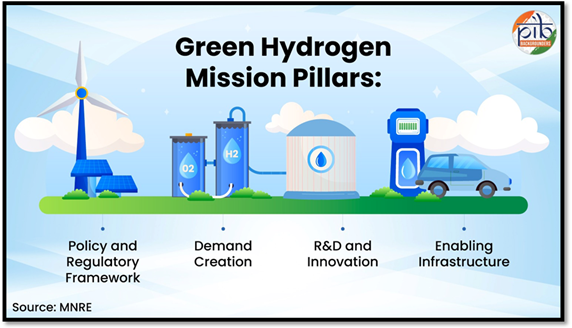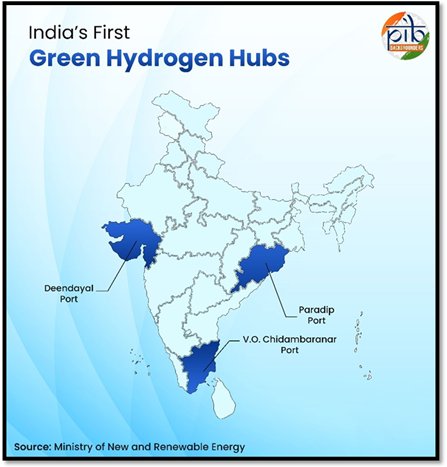Energy & Environment
Unlocking India’s Green Hydrogen Production Potential
Posted On:
12 NOV 2025 1:35PM
|
- India targets 5 MMT of Green Hydrogen production annually by 2030.
- India’s first port-based Green Hydrogen pilot commissioned at V.O. Chidambaranar Port.
- Hydrogen mobility pilots launched across 10 routes, involving 37 fuel cell and hydrogen internal combustion engine vehicles.
- The Mission is expected to attract over ₹8 lakh crore in investments and reduce fossil fuel imports by more than ₹1 lakh crore.
|
Introduction
India’s energy transition is entering a decisive phase, as the country reduces its dependence on fossil fuels and increases domestic clean energy production. This is in line with its vision of becoming a developed nation by 2047 and achieving Net Zero by 2070. In this transition, Green hydrogen, has emerged as a clean, scalable fuel alternative that can decarbonize hard-to-abate sectors, reduce import dependence on fossil fuels, and support India’s goals for energy security and industrial growth.
The Indian government launched the National Green Hydrogen Mission (NGHM) in 2023, as an umbrella programme that aims to establish a Green Hydrogen ecosystem and catalyse a systemic response to the opportunities and challenges in this sector.
Objectives
The Mission represents more than an energy initiative; it is a strategic pathway toward industrial competitiveness, import reduction, and long-term energy security—linking sustainability with self-reliance.
What is Green Hydrogen?
Green Hydrogen is Hydrogen produced using renewable energy, such as solar or wind power, instead of fossil fuels. In this process water is split into hydrogen and oxygen through electrolysis, using electricity from solar panels or wind turbines. According to standards notified by Govt of India, Hydrogen made this way is considered “green” if the total emissions from the process are very low, not more than 2 kg of CO₂ equivalent for every 1 kg of Hydrogen produced. Green Hydrogen can also be produced by converting biomass (like agricultural waste) into hydrogen, as long as emissions remain below the same limit.
The National Green Hydrogen Mission (NGHM) aims to build the capacity and ecosystem required to position India as a global leader in clean hydrogen. By 2030, the Mission will be supported by about 125 GW of new renewable energy capacity dedicated to green hydrogen production, along with investments exceeding ₹8 lakh crore. The Mission is expected to create over 6 lakh jobs, reduce fossil fuel imports by more than ₹1 lakh crore, and avoid nearly 50 MMT of greenhouse gas emissions every year by 2030.

As of May 2025, 19 companies have been allocated a cumulative annual production capacity of 862,000 tonnes of Green Hydrogen every year and 15 firms have been awarded a 3,000 MW annual electrolyzer manufacturing capacity. India has also launched pilot project in steel, mobility and shipping sectors.
Sectoral Innovation & Implementation Under NGHM
Launched in January 2023, the National Green Hydrogen Mission has an initial outlay of ₹19,744 crore till Financial Year 2029-30. This includes ₹17,490 crore for the Strategic Interventions for Green Hydrogen Transition (SIGHT) programme, ₹1,466 crore for pilot projects, ₹400 crore for research and development (R&D), and ₹388 crore towards other Mission components.
The Mission focuses on four key pillars, including policy and regulatory framework, demand creation, research and development & innovation, and enabling infrastructure and ecosystem development — aimed at positioning India as a global hub for green hydrogen production, use, and export.

To augment the Mission’s vision, the government has also launched multiple schemes to accelerate production and use of green hydrogen, promote domestic manufacturing and exports, ensure regulatory compliance, and strengthen public–private partnerships.
(i) Strategic Interventions for Green Hydrogen Transition (SIGHT) Scheme: A financial incentive mechanism with an outlay of ₹ 17,490 crore up to 2029-30 provides incentives for the manufacturing of electrolysers that are used for production of green hydrogen.
(ii) Development of Green Hydrogen Hubs: In October 2025, the Ministry of New and Renewable Energy (MNRE) has announced the recognition of three major ports Deendayal Port Authority (Gujarat), V.O. Chidambaranar Port Authority (Tamil Nadu), and Paradip Port Authority (Odisha) as Green Hydrogen Hubs under the NGHM.These coastal gateways will serve as integrated centres for production, consumption, and future export.

(iii) Standards, Certification and Safety: Launched in April 2025, the Green Hydrogen Certification Scheme of India (GHCI) provides a national framework to certify hydrogen as “green” by assessing its greenhouse gas emissions across the entire production cycle. The scheme ensures that only hydrogen produced using renewable energy, and within the prescribed emission limits, can be officially labeled as Green Hydrogen. It provides transparency, traceability, and credibility for producers, buyers, and export markets.
Under the GHCI, obtaining a ‘Final Certificate’ is mandatory for any green hydrogen production facility in India that (a) receives subsidies or incentives from the central or state governments, or (b) sells or uses the hydrogen domestically (in India).
The Bureau of Energy Efficiency (BEE) is the Nodal Authority responsible for accrediting agencies that monitor and certify projects.
(iv) Strategic Hydrogen Innovation Partnership (SHIP): The Mission fosters public-private partnerships for R&D through the Strategic Hydrogen Innovation Partnership (SHIP). It is designed to support the development of advanced, globally competitive hydrogen technologies through collaborative research involving Government institutions, industry, and academic organisations. The programme includes the creation of a dedicated R&D fund with contributions from both the Government and industry. Under SHIP, consortium-based research will be encouraged to leverage the strengths of national scientific institutions such as BARC, ISRO, CSIR, IITs, IISc, and other partners. The objective is to drive innovation across the Green Hydrogen value chain and support domestic manufacturing capability.
Adedicated ₹400 crore R&D scheme under the Mission is already powering 23 cutting-edge projects across areas such as hydrogen production, safety systems, storage, and industrial applications. In addition, a ₹100 crore Call for Proposals has been launched to support start-ups working on innovative technologies for hydrogen production, storage, transport and utilisation, with funding of up to ₹5 crore per project. These initiatives are aimed at developing globally competitive technologies and reducing costs across the hydrogen value chain.
The second round of R&D proposals, launched in July 2025 focuses on collaborative research and industry participation, with over 30 joint proposals internationally submitted under the EU–India Trade and Technology Council.
Pathways For Adoption
The roadmap is not just limited to forming policies and providing subsidies, but green hydrogen is also being introduced in key sectors to reduce emissions, supporting domestic manufacturing, and replacing fossil-based hydrogen and feedstock. The NGHM is facilitating applications across industry, mobility, and infrastructure.
Industrial
- Fertilizers: Replacing fossil-fuel-based feedstocks with Green Ammonia. A recent auction for a long-term supply of green ammonia to fertilizer units, with an aggregate procurement capacity of 7.24 lakh metric tonnes per annum,at a price of ₹55.75 per kg.
- Petroleum Refining: The Mission is seamlessly facilitating the replacement of fossil-based hydrogen with green hydrogen in refineries, directly reducing the carbon footprint of this essential industry.
- Steel: Five pilot projects have been initiated in collaboration with public and private steel producers to evaluate the use of Green Hydrogen for iron reduction and other process applications. These pilots are designed to assess the technical feasibility, economic viability and safety of hydrogen-based steelmaking in Indian operating conditions.
Mobility and Transport
- Road Transport: In March, five major pilot projects were initiated involving 37 hydrogen vehicle (buses and trucks), and 9 refueling stations across 10 different routes. The vehicles to be deployed for the trial include 15 hydrogen fuel cell-based vehicles and 22 hydrogen internal combustion engine-based vehicles. The financial support for the project would be around Rs. 208 crore.
- Shipping: India’s first port-based Green Hydrogen Pilot Projectwas commissioned at V.O. Chidambaranar Port in September 2025. The₹25 crore, 10 Nm³/hr facility will produce green hydrogen for local applications, including street lighting and an EV charging station. A ₹42 crore, 750 m³ Green Methanol Bunkering and Refuelling Facility is also being developed to support cleaner maritime operations and enable a Coastal Green Shipping Corridor between Kandla and Tuticorin.
- High-Altitude Mobility: NTPC in November 2024was commissioned the world's highest altitude(3,650 m) Green Hydrogen Mobility Project in Leh, which includes 5 hydrogen intra-city buses and a fuelling station proving the fuel's reliability in extreme conditions. This station shall mitigate the carbon emissions of approx. 350 MT/year and contribute 230 MT/year of pure oxygen into the atmosphere which is equal to planting of approx. 13000 trees.
Enabling Framework:
Beyond direct incentives, a comprehensive enabling framework is being established to de-risk investments and accelerate development.
- Policy Framework: To facilitate the delivery of low-cost renewable energy for hydrogen production, the government has provided a waiver of Interstate transmission charges and ensured a time-bound grant of Open Access.
- Skill Development: A coordinated skill development programme is being implemented, which has already led to the certification of more than 5,600 trainees in hydrogen-related qualifications, building a future-ready workforce.
Building Global Partnerships
In 2024, India made its debut in the international hydrogen community at the World Hydrogen Summit in Rotterdam with the inauguration of its first India Pavilion. This positions India as a prime partner for global investment, and key partner in the emerging global hydrogen economy.
- EU-India Collaboration: Under the EU-India Trade and Technology Council, collaboration is expanding, with over 30 joint proposals received on hydrogen production from waste.
- India-UK Partnership: A dedicated Standards Partnership Workshop in February 2025was held to strengthen cooperation on hydrogen standardization, focusing on safe, scalable, and globally harmonized Regulations, Codes and Standards (RCS) to enhance trade.
- Partnership with H2Global: In November 2024, Solar Energy Corporation of India (SECI) signed an MoU with Germany's H2Global Stiftung to collaborate on market-based mechanisms and joint tender designs, facilitating the export of Indian green hydrogen to international markets.
- Singapore: In October 2025, Sembcorp Industries signed MoUs with V.O. Chidambaranar and Paradip Port Authorities to develop integrated green-hydrogen and ammonia hubs for production, storage and exports.
Conclusion: A Legacy of Clean Growth
Green hydrogen stands at the center of India’s clean energy strategy, driving the shift toward a low-carbon and self-reliant economy. Building on one of the world’s most competitive renewable energy bases, the National Green Hydrogen Mission is expanding domestic production, scaling innovation, and opening global markets for green hydrogen and its derivatives. The Mission reduces dependence on fossil fuels, accelerates industrial transformation, and positions India to lead with credibility in the global clean energy transition—advancing a future that is sustainable, secure, and self-sustained.
References
Ministry of New and Renewable Energy
Download in PDF
***
M
(Backgrounder ID: 155990)
Visitor Counter : 401
Provide suggestions / comments